One of the most prized artists of the Golden Age of Book Illustration Edmund Dulac’s distinctive paintings are stunningly atmospheric.
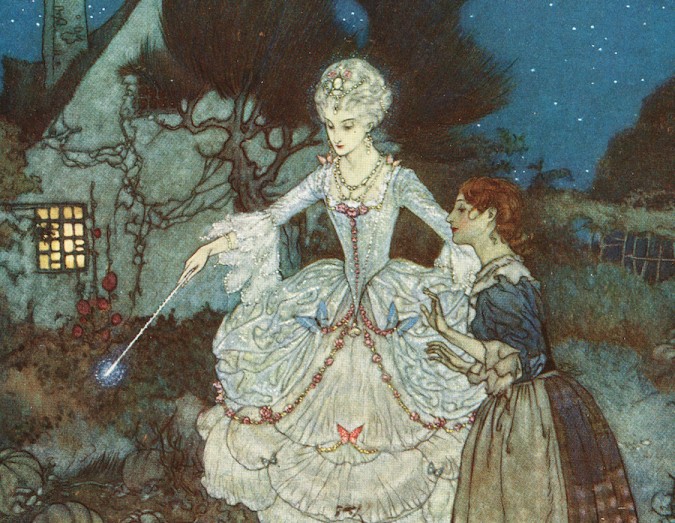
Born and brought up in Toulouse, France, Dulac was always an Anglophile, at art college he dressed in English style clothes, adopted English mannerisms and was nicknamed “L’Anglais.” He emigrated to England in 1905 and by the age of 29 had become a British citizen.
Dulac’s first book commission was to provide illustrations for a set of novels by the Brontë sisters. Around the same time Hodder and Stoughton had commissioned Laurence Housman to write a version of the Arabian Nights, on seeing Dulac’s drawings for Jane Eyre they approached him with a request for fifty watercolours to accompany Housman’s Arabian Nights. The publication of Dulac and Housman’s Stories from the Arabian Nights was launched with some aplomb accompanied by a selling exhibition of the original watercolours at the Leicester Galleries, London. The book was issued in both a cloth bound edition and a magnificent vellum bound version, sold to subscribers and signed by the artist. So popular was the book that for a time Dulac was referred to as “The Arabian Nights Man.” Indeed he was to return to the Arabian Night’s tales on several occasions, with titles such as Sindbad the Sailor and Princess Badoura.
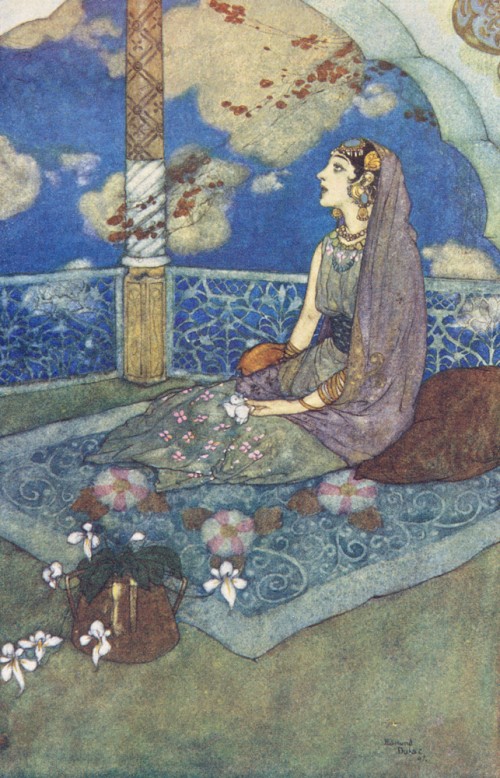
Dulac's illustration to Omar Khayyam's Rubaiyat allow him to explore Persian themes
The Arabian Nights was to be the first in a string of elaborate gift books published to coincide with the Christmas gift market. The highest paid illustrator of the period, books bearing Dulac’s name sold tremendously well and the expensive Editions de Luxe were always over subscribed. The illustrations of his early career those such for The Arabian Nights, Sleeping Beauty, Hans Andersen’s Fairy Tales and The Rubaiyat of Omar Khayyam are distinctive for their use of a deeply rich colour palette. He particularly favoured a deep blue tone, chosen not only for its hue, but also for the play on words created by its name, bleu du lac. His paintings from this era, his blue period, are characterized by dark, starry skies, twilight scenes and icy blue landscapes.
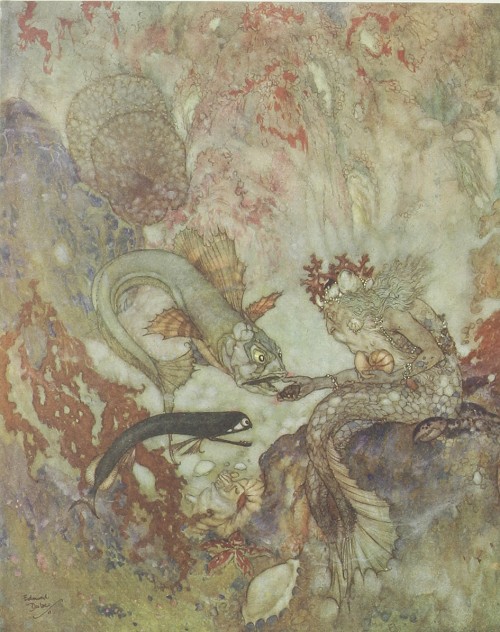
The Little Mermaid, from Dulac's 1911 triumph, Stories from Hans Andersen
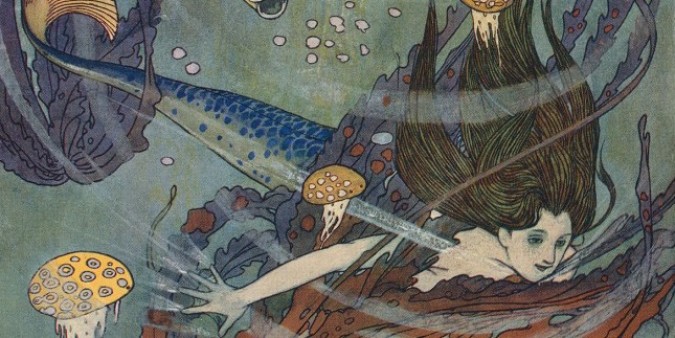
U is for Undine, from Lyrics Pathetic and Humorous
As time went on Dulac’s fascination with the art of the Orient began to influence his work. His uncle was an antique dealer handling Oriental art and artifacts and from an early age Dulac had been entranced by the exoticism of Oriental design. Such was his attention to detail that he threw himself into his research of the subject taking an interest not only in the art and culture of the region, but he also learning to speak both Arabic and Chinese.
In an introduction to a New York exhibition of Dulac’s work it is said of the artist “ … he would have chosen some dream city of the Orient for his birthplace, a Persian princess for his mother, and an artist of the Ming Dynasty for his father.”
The influence of the Orient is particularly evident in Princess Badoura, 1913 and Sinbad the Sailor, 1914.
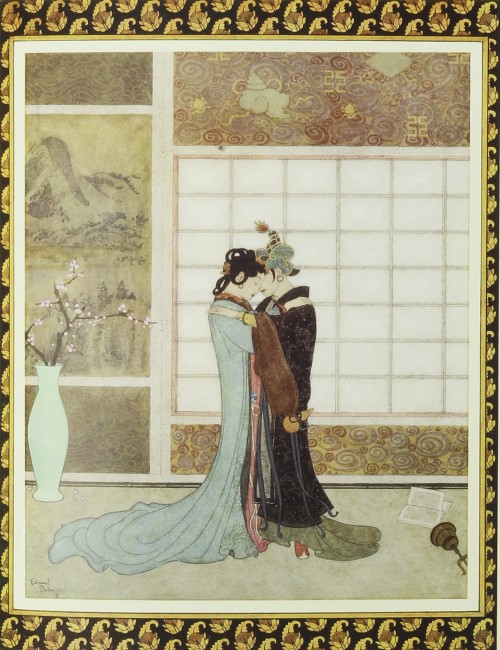
Oriental twists to the Arabian Nights Tales in Princess Badoura
The outbreak of the First World War heralded an end to the era of opulent gift books. During this time The Daily Telegraph joined forces with Hodder and Stoughton to raise funds in support of the French Red Cross and who could be more appropriate to illustrate the volume of fairy tales than French artist Edmund Dulac. He chose some of his most popular illustrations form earlier books and added three brand new ones. Priced at just 3 shillings the book proved hugely popular, within the book reproduced below a photograph of the artist is his handwritten plea: " If any reader of my picture book would like to make a direct contribution to the French Red Cross, I should be very proud to receive it and acknowledge it. France bled of treasure and supplies is giving all she can. Can you not spare something towards this work of mercy and healing among our most gallant Allies?"
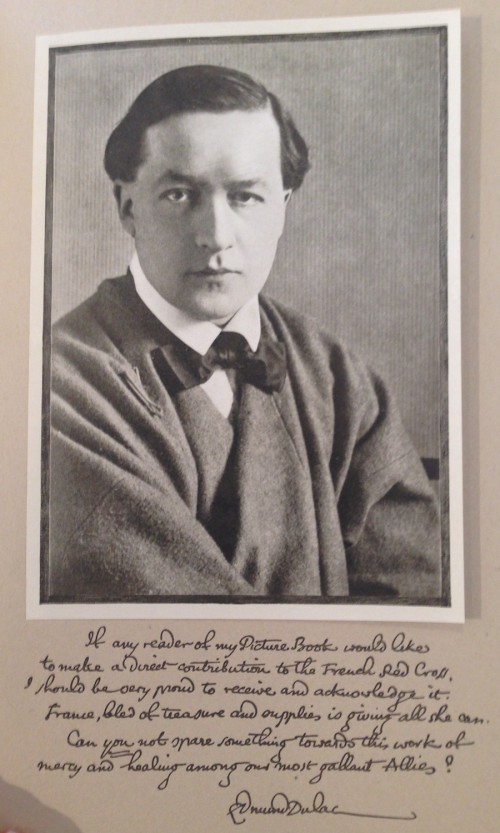
Edmund Dulac's fund raising plea from his Picture Book for the French Red Cross
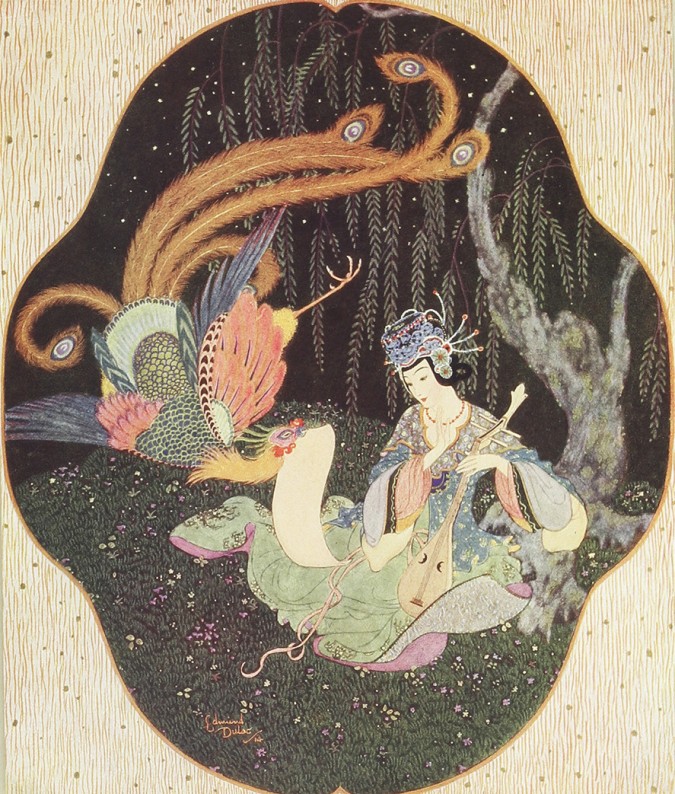
The Firebird, from Picture Book for the French Red Cross
After the war Dulac continued to work on book illustrations, though the productions became less elaborate and the style of his drawing entered a final phase employing a more subtle palette of blues and greens. In 1927 he provided paintings for a volume of Robert Louis Stevenson’s Treasure Island, the drawings were the artist’s own favourites among his work and the Edition de Luxe produced in an edition of just 50 copies is now one of the most prized books of this genre.
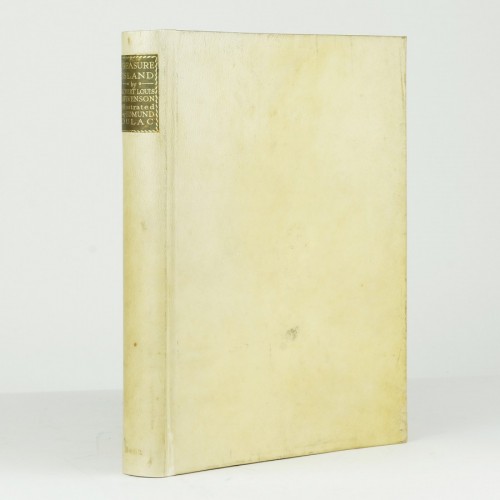
Dulac's Treasure Island with only 50 copies printed is a great rarity
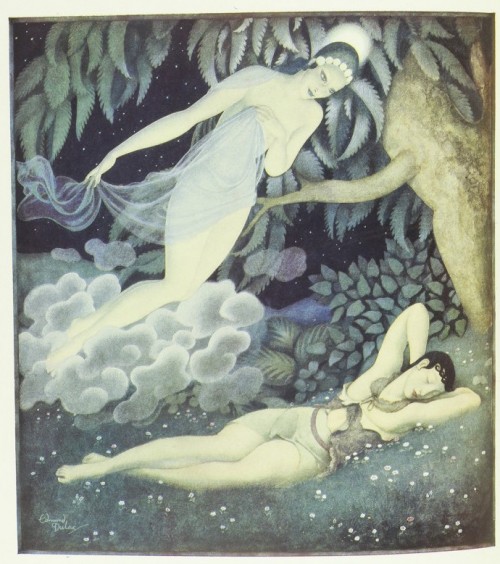
God and Mortals in Love, 1936 has an Art Deco feel
Edmund Dulac was a man of passion who threw himself into projects wholeheartedly and thus it seems fitting that his life would come to an end, at the age of 70, after an evening of particularly strenuous flamenco dancing. He left behind him a legacy of wonderfully enchanting books.
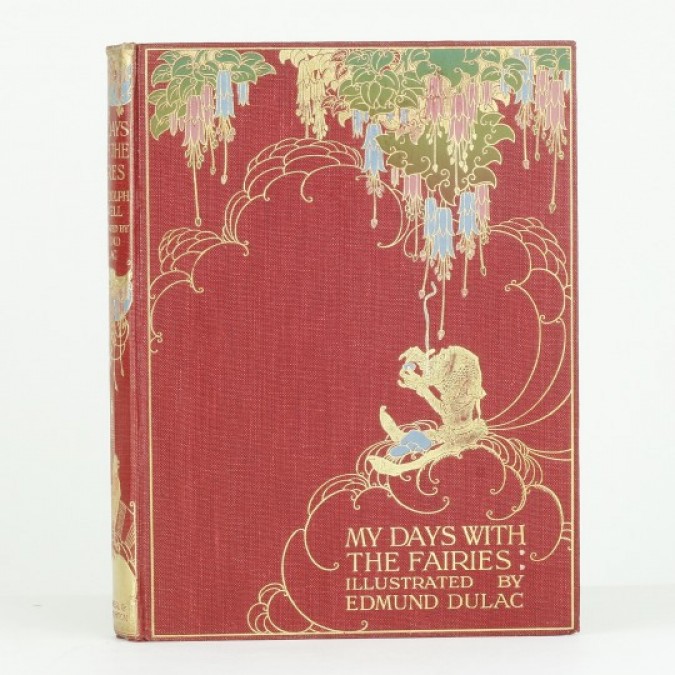
The 1920 edition of My Days with the Fairies with its highly decorative cover
Browse more of Edmund Dulac’s books and illustrations.
Edmund Dulac Bibliography, Principle books Illustrated
1905 The Novels of the Brontë Sisters
1907 Fairies I Have Met
1907 Stories from the Arabian Nights
1908 The Tempest
1908 Lyrics Pathetic and Humorous from A-Z
1909 The Rubaiyat of Omar Khayyam
1911 Stories from Hans Andersen
1912 The Bells and other Poems by Edgar Allan Poe
1913 Princess Badoura
1914 Sindbad the Sailor and other Stories from the Arabian Nights
1915 The Dreamer of Dreams
1916 Picture Book for the French Red Cross
1916 Edmund Dulac’s Fairy Book
1918 Tanglewood Tales
1920 The Kingdom of the Pearl
1927 Treasure Island
1928 A Fairy Garland
1950 The Golden Cockerel
1951 The Marriage of Cupid and Psyche
1954 The Masque of Comus
Recent Posts
- The Evolution of Crime
- Tour The Bookshop On Your Screen
- The Genesis of Mr. Toad: A Short Publication History of The Wind In The Willows
- Frank Hurley's 'South'
- The "Other" Florence Harrison
- Picturing Enid Blyton
- Advent Calendar of Illustration 2020
- Depicting Jeeves and Wooster
- Evelyn Waugh Reviews Nancy Mitford
- The Envelope Booklets of T.N. Foulis
- "To Die Like English Gentlemen"
- Kay Nielsen's Fantasy World
- A Brief Look at Woodcut Illustration
- The Wealth Of Nations by Adam Smith
- What Big Stories You Have: Brothers Grimm
- Shackleton's Antarctic Career
- Inspiring Errol Le Cain's Fantasy Artwork
- Charlie & The Great Glass Elevator
- Firsts London - An Audio Tour Of Our Booth
- Jessie M. King's Poetic Art, Books & Jewellery
Blog Archive
- January 2024 (1)
- January 2023 (1)
- August 2022 (1)
- January 2022 (1)
- February 2021 (1)
- January 2021 (1)
- December 2020 (1)
- August 2020 (1)
- July 2020 (2)
- March 2020 (3)
- February 2020 (2)
- October 2019 (2)
- July 2019 (2)
- May 2019 (1)
- April 2019 (1)
- March 2019 (2)
- February 2019 (1)
- December 2018 (1)
- November 2018 (1)
- October 2018 (2)